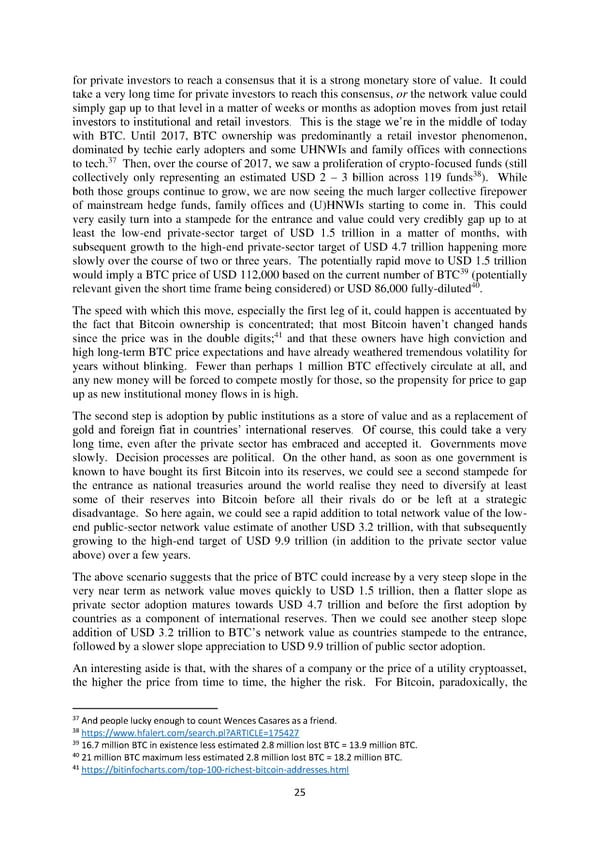for private investors to reach a consensus that it is a strong monetary store of value. It could take a very long time for private investors to reach this consensus, or the network value could simply gap up to that level in a matter of weeks or months as adoption moves from just retail investors to institutional and retail investors. This is the stage we’re in the middle of today with BTC. Until 2017, BTC ownership was predominantly a retail investor phenomenon, dominated by techie early adopters and some UHNWIs and family offices with connections to tech.37 Then, over the course of 2017, we saw a proliferation of crypto-focused funds (still collectively only representing an estimated USD 2 – 3 billion across 119 funds38). While both those groups continue to grow, we are now seeing the much larger collective firepower of mainstream hedge funds, family offices and (U)HNWIs starting to come in. This could very easily turn into a stampede for the entrance and value could very credibly gap up to at least the low-end private-sector target of USD 1.5 trillion in a matter of months, with subsequent growth to the high-end private-sector target of USD 4.7 trillion happening more slowly over the course of two or three years. The potentially rapid move to USD 1.5 trillion would imply a BTC price of USD 112,000 based on the current number of BTC39 (potentially relevant given the short time frame being considered) or USD 86,000 fully-diluted40. The speed with which this move, especially the first leg of it, could happen is accentuated by the fact that Bitcoin ownership is concentrated; that most Bitcoin haven’t changed hands since the price was in the double digits;41 and that these owners have high conviction and high long-term BTC price expectations and have already weathered tremendous volatility for years without blinking. Fewer than perhaps 1 million BTC effectively circulate at all, and any new money will be forced to compete mostly for those, so the propensity for price to gap up as new institutional money flows in is high. The second step is adoption by public institutions as a store of value and as a replacement of gold and foreign fiat in countries’ international reserves. Of course, this could take a very long time, even after the private sector has embraced and accepted it. Governments move slowly. Decision processes are political. On the other hand, as soon as one government is known to have bought its first Bitcoin into its reserves, we could see a second stampede for the entrance as national treasuries around the world realise they need to diversify at least some of their reserves into Bitcoin before all their rivals do or be left at a strategic disadvantage. So here again, we could see a rapid addition to total network value of the low- end public-sector network value estimate of another USD 3.2 trillion, with that subsequently growing to the high-end target of USD 9.9 trillion (in addition to the private sector value above) over a few years. The above scenario suggests that the price of BTC could increase by a very steep slope in the very near term as network value moves quickly to USD 1.5 trillion, then a flatter slope as private sector adoption matures towards USD 4.7 trillion and before the first adoption by countries as a component of international reserves. Then we could see another steep slope addition of USD 3.2 trillion to BTC’s network value as countries stampede to the entrance, followed by a slower slope appreciation to USD 9.9 trillion of public sector adoption. An interesting aside is that, with the shares of a company or the price of a utility cryptoasset, the higher the price from time to time, the higher the risk. For Bitcoin, paradoxically, the 37 And people lucky enough to count Wences Casares as a friend. 38 https://www.hfalert.com/search.pl?ARTICLE=175427 39 16.7 million BTC in existence less estimated 2.8 million lost BTC = 13.9 million BTC. 40 21 million BTC maximum less estimated 2.8 million lost BTC = 18.2 million BTC. 41 https://bitinfocharts.com/top-100-richest-bitcoin-addresses.html 25
 Investor’s Take on Cryptoassets by John Pfeffer Page 24 Page 26
Investor’s Take on Cryptoassets by John Pfeffer Page 24 Page 26